Analyzing Fracking, Climate Change, Corporate Power, and Democracy
VerifiedAdded on 2023/03/21
|12
|3094
|21
Homework Assignment
AI Summary
This assignment delves into the history of fracking, examining its evolution from early experiments to modern practices, including technological advancements and corporate interests. It investigates the environmental consequences of fracking, such as water pollution, air pollution, land use, and increased seismic activity, while also exploring the link between non-renewable fossil fuel industries and climate change, focusing on greenhouse gas emissions and their impacts. Furthermore, the assignment discusses strategies for reigning in corporate power, rebuilding local economies, and reclaiming democracy by analyzing policies, promoting sustainable practices, and encouraging community participation to address environmental issues and promote societal well-being. The assignment also covers how non-renewable fossil fuels cause climate change and suggests ways to improve the economy.
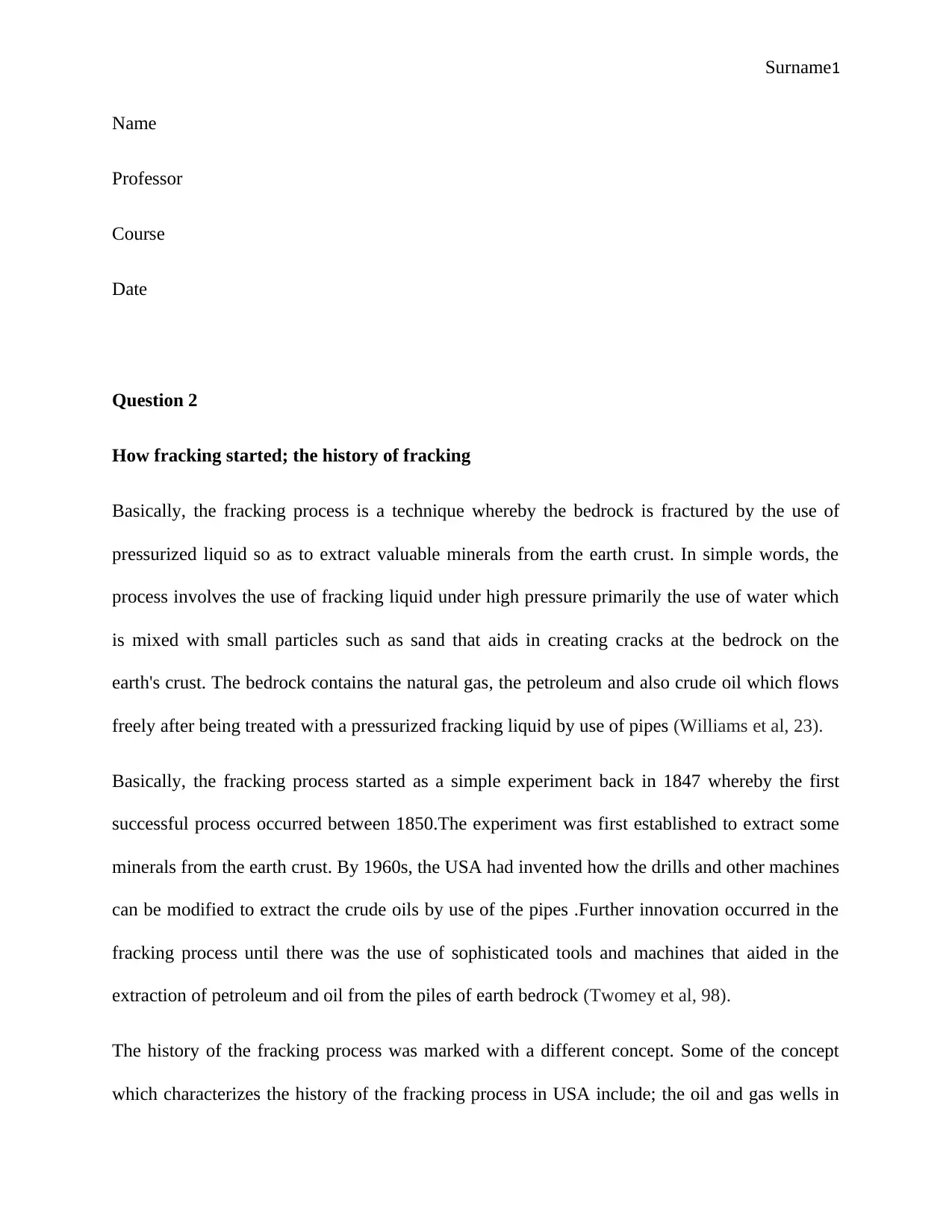
Surname1
Name
Professor
Course
Date
Question 2
How fracking started; the history of fracking
Basically, the fracking process is a technique whereby the bedrock is fractured by the use of
pressurized liquid so as to extract valuable minerals from the earth crust. In simple words, the
process involves the use of fracking liquid under high pressure primarily the use of water which
is mixed with small particles such as sand that aids in creating cracks at the bedrock on the
earth's crust. The bedrock contains the natural gas, the petroleum and also crude oil which flows
freely after being treated with a pressurized fracking liquid by use of pipes (Williams et al, 23).
Basically, the fracking process started as a simple experiment back in 1847 whereby the first
successful process occurred between 1850.The experiment was first established to extract some
minerals from the earth crust. By 1960s, the USA had invented how the drills and other machines
can be modified to extract the crude oils by use of the pipes .Further innovation occurred in the
fracking process until there was the use of sophisticated tools and machines that aided in the
extraction of petroleum and oil from the piles of earth bedrock (Twomey et al, 98).
The history of the fracking process was marked with a different concept. Some of the concept
which characterizes the history of the fracking process in USA include; the oil and gas wells in
Name
Professor
Course
Date
Question 2
How fracking started; the history of fracking
Basically, the fracking process is a technique whereby the bedrock is fractured by the use of
pressurized liquid so as to extract valuable minerals from the earth crust. In simple words, the
process involves the use of fracking liquid under high pressure primarily the use of water which
is mixed with small particles such as sand that aids in creating cracks at the bedrock on the
earth's crust. The bedrock contains the natural gas, the petroleum and also crude oil which flows
freely after being treated with a pressurized fracking liquid by use of pipes (Williams et al, 23).
Basically, the fracking process started as a simple experiment back in 1847 whereby the first
successful process occurred between 1850.The experiment was first established to extract some
minerals from the earth crust. By 1960s, the USA had invented how the drills and other machines
can be modified to extract the crude oils by use of the pipes .Further innovation occurred in the
fracking process until there was the use of sophisticated tools and machines that aided in the
extraction of petroleum and oil from the piles of earth bedrock (Twomey et al, 98).
The history of the fracking process was marked with a different concept. Some of the concept
which characterizes the history of the fracking process in USA include; the oil and gas wells in
Paraphrase This Document
Need a fresh take? Get an instant paraphrase of this document with our AI Paraphraser
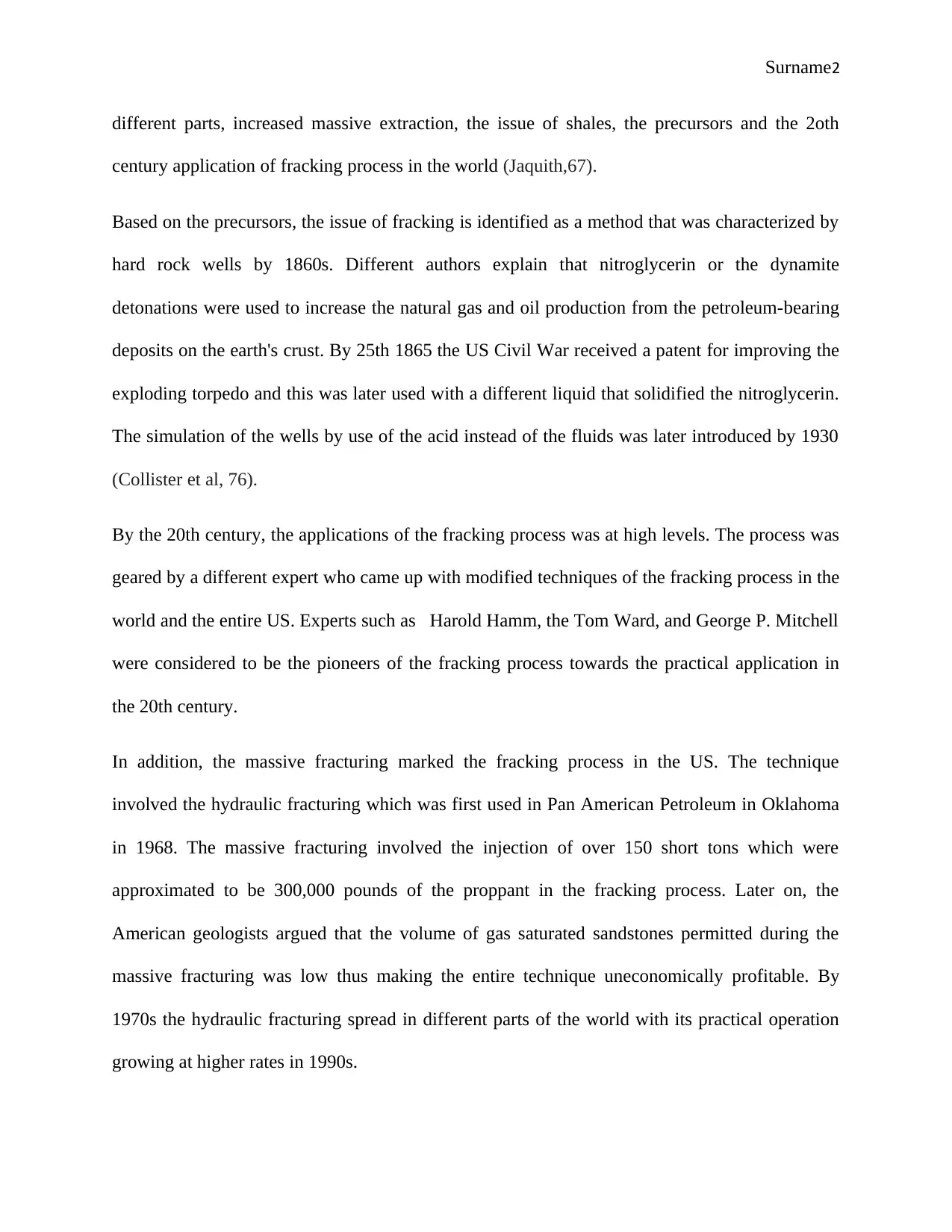
Surname2
different parts, increased massive extraction, the issue of shales, the precursors and the 2oth
century application of fracking process in the world (Jaquith,67).
Based on the precursors, the issue of fracking is identified as a method that was characterized by
hard rock wells by 1860s. Different authors explain that nitroglycerin or the dynamite
detonations were used to increase the natural gas and oil production from the petroleum-bearing
deposits on the earth's crust. By 25th 1865 the US Civil War received a patent for improving the
exploding torpedo and this was later used with a different liquid that solidified the nitroglycerin.
The simulation of the wells by use of the acid instead of the fluids was later introduced by 1930
(Collister et al, 76).
By the 20th century, the applications of the fracking process was at high levels. The process was
geared by a different expert who came up with modified techniques of the fracking process in the
world and the entire US. Experts such as Harold Hamm, the Tom Ward, and George P. Mitchell
were considered to be the pioneers of the fracking process towards the practical application in
the 20th century.
In addition, the massive fracturing marked the fracking process in the US. The technique
involved the hydraulic fracturing which was first used in Pan American Petroleum in Oklahoma
in 1968. The massive fracturing involved the injection of over 150 short tons which were
approximated to be 300,000 pounds of the proppant in the fracking process. Later on, the
American geologists argued that the volume of gas saturated sandstones permitted during the
massive fracturing was low thus making the entire technique uneconomically profitable. By
1970s the hydraulic fracturing spread in different parts of the world with its practical operation
growing at higher rates in 1990s.
different parts, increased massive extraction, the issue of shales, the precursors and the 2oth
century application of fracking process in the world (Jaquith,67).
Based on the precursors, the issue of fracking is identified as a method that was characterized by
hard rock wells by 1860s. Different authors explain that nitroglycerin or the dynamite
detonations were used to increase the natural gas and oil production from the petroleum-bearing
deposits on the earth's crust. By 25th 1865 the US Civil War received a patent for improving the
exploding torpedo and this was later used with a different liquid that solidified the nitroglycerin.
The simulation of the wells by use of the acid instead of the fluids was later introduced by 1930
(Collister et al, 76).
By the 20th century, the applications of the fracking process was at high levels. The process was
geared by a different expert who came up with modified techniques of the fracking process in the
world and the entire US. Experts such as Harold Hamm, the Tom Ward, and George P. Mitchell
were considered to be the pioneers of the fracking process towards the practical application in
the 20th century.
In addition, the massive fracturing marked the fracking process in the US. The technique
involved the hydraulic fracturing which was first used in Pan American Petroleum in Oklahoma
in 1968. The massive fracturing involved the injection of over 150 short tons which were
approximated to be 300,000 pounds of the proppant in the fracking process. Later on, the
American geologists argued that the volume of gas saturated sandstones permitted during the
massive fracturing was low thus making the entire technique uneconomically profitable. By
1970s the hydraulic fracturing spread in different parts of the world with its practical operation
growing at higher rates in 1990s.
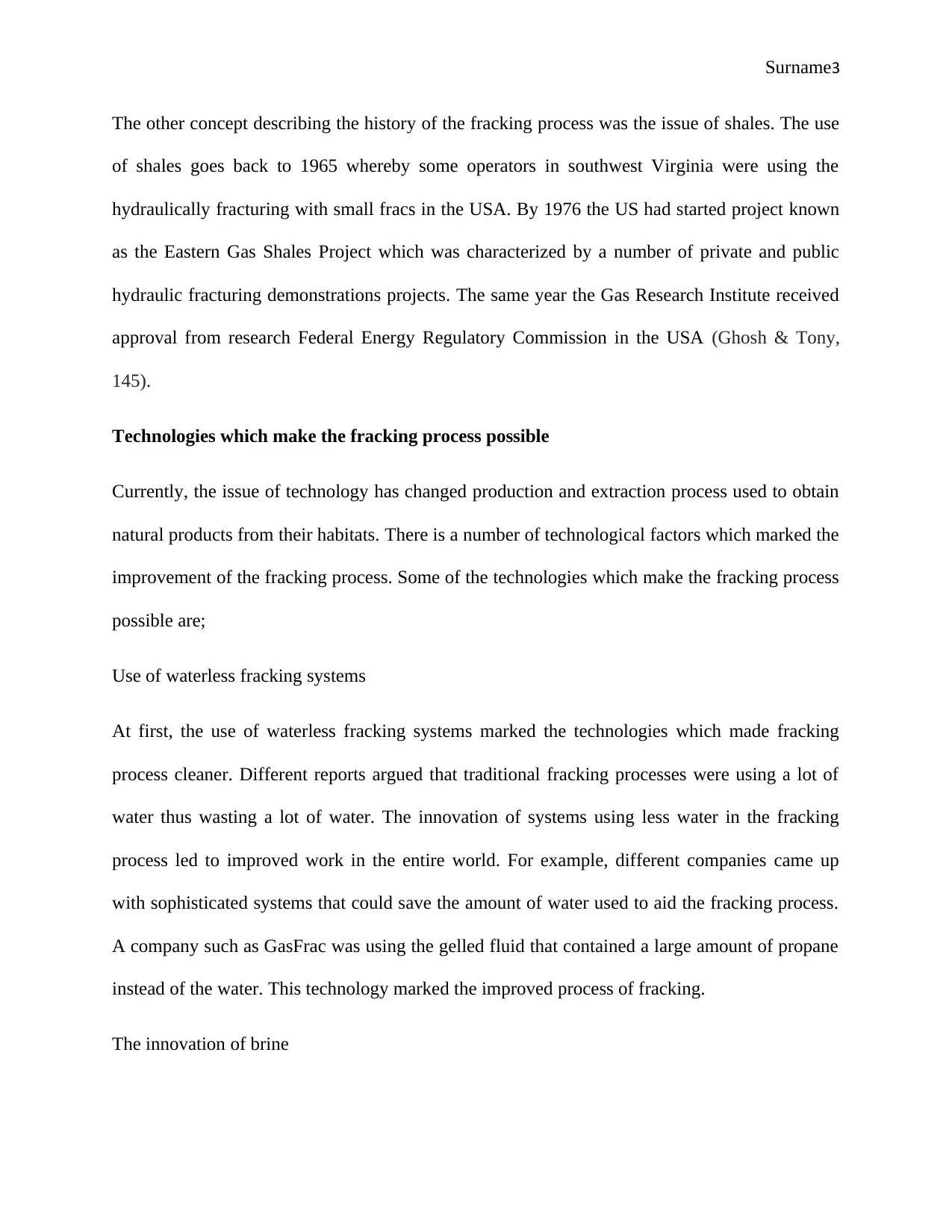
Surname3
The other concept describing the history of the fracking process was the issue of shales. The use
of shales goes back to 1965 whereby some operators in southwest Virginia were using the
hydraulically fracturing with small fracs in the USA. By 1976 the US had started project known
as the Eastern Gas Shales Project which was characterized by a number of private and public
hydraulic fracturing demonstrations projects. The same year the Gas Research Institute received
approval from research Federal Energy Regulatory Commission in the USA (Ghosh & Tony,
145).
Technologies which make the fracking process possible
Currently, the issue of technology has changed production and extraction process used to obtain
natural products from their habitats. There is a number of technological factors which marked the
improvement of the fracking process. Some of the technologies which make the fracking process
possible are;
Use of waterless fracking systems
At first, the use of waterless fracking systems marked the technologies which made fracking
process cleaner. Different reports argued that traditional fracking processes were using a lot of
water thus wasting a lot of water. The innovation of systems using less water in the fracking
process led to improved work in the entire world. For example, different companies came up
with sophisticated systems that could save the amount of water used to aid the fracking process.
A company such as GasFrac was using the gelled fluid that contained a large amount of propane
instead of the water. This technology marked the improved process of fracking.
The innovation of brine
The other concept describing the history of the fracking process was the issue of shales. The use
of shales goes back to 1965 whereby some operators in southwest Virginia were using the
hydraulically fracturing with small fracs in the USA. By 1976 the US had started project known
as the Eastern Gas Shales Project which was characterized by a number of private and public
hydraulic fracturing demonstrations projects. The same year the Gas Research Institute received
approval from research Federal Energy Regulatory Commission in the USA (Ghosh & Tony,
145).
Technologies which make the fracking process possible
Currently, the issue of technology has changed production and extraction process used to obtain
natural products from their habitats. There is a number of technological factors which marked the
improvement of the fracking process. Some of the technologies which make the fracking process
possible are;
Use of waterless fracking systems
At first, the use of waterless fracking systems marked the technologies which made fracking
process cleaner. Different reports argued that traditional fracking processes were using a lot of
water thus wasting a lot of water. The innovation of systems using less water in the fracking
process led to improved work in the entire world. For example, different companies came up
with sophisticated systems that could save the amount of water used to aid the fracking process.
A company such as GasFrac was using the gelled fluid that contained a large amount of propane
instead of the water. This technology marked the improved process of fracking.
The innovation of brine
⊘ This is a preview!⊘
Do you want full access?
Subscribe today to unlock all pages.

Trusted by 1+ million students worldwide
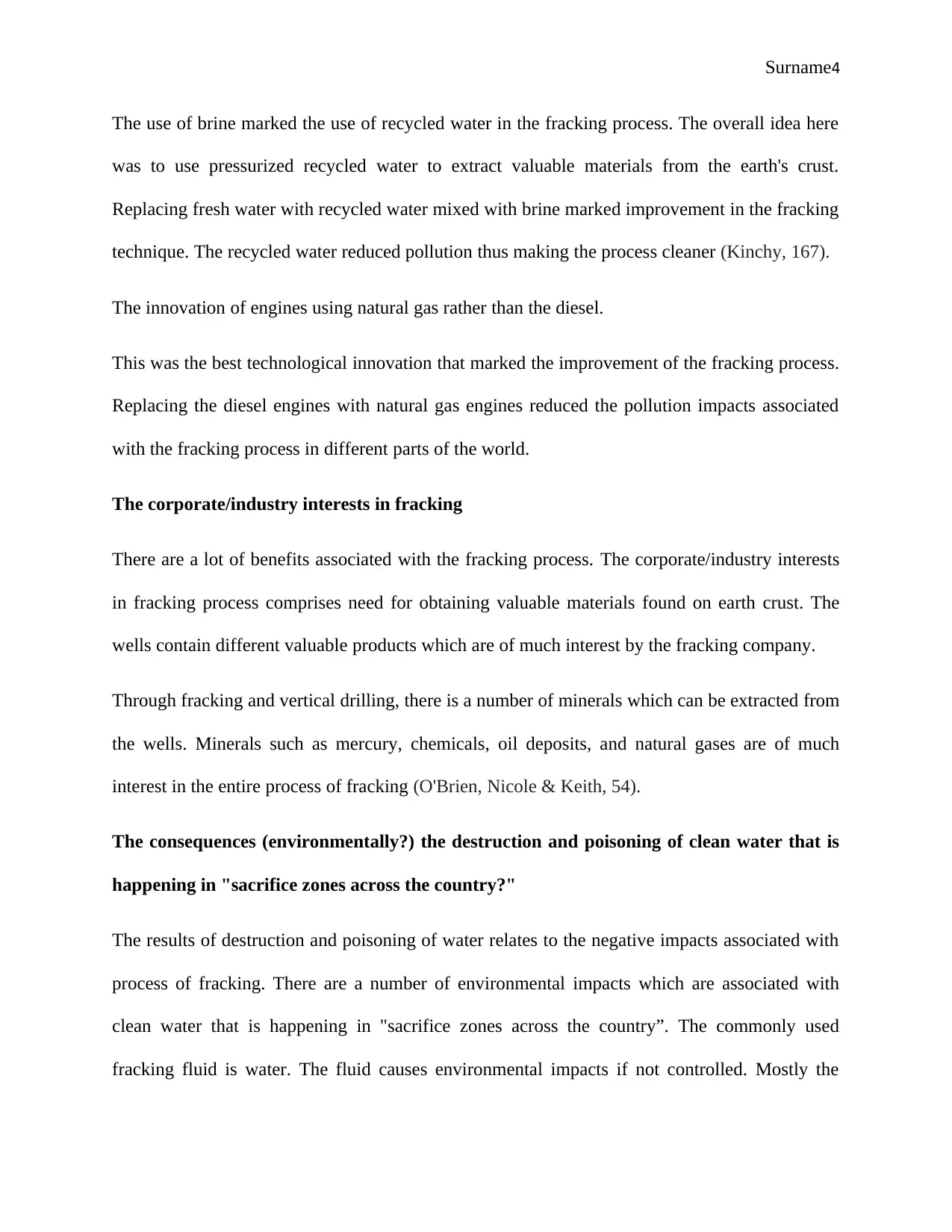
Surname4
The use of brine marked the use of recycled water in the fracking process. The overall idea here
was to use pressurized recycled water to extract valuable materials from the earth's crust.
Replacing fresh water with recycled water mixed with brine marked improvement in the fracking
technique. The recycled water reduced pollution thus making the process cleaner (Kinchy, 167).
The innovation of engines using natural gas rather than the diesel.
This was the best technological innovation that marked the improvement of the fracking process.
Replacing the diesel engines with natural gas engines reduced the pollution impacts associated
with the fracking process in different parts of the world.
The corporate/industry interests in fracking
There are a lot of benefits associated with the fracking process. The corporate/industry interests
in fracking process comprises need for obtaining valuable materials found on earth crust. The
wells contain different valuable products which are of much interest by the fracking company.
Through fracking and vertical drilling, there is a number of minerals which can be extracted from
the wells. Minerals such as mercury, chemicals, oil deposits, and natural gases are of much
interest in the entire process of fracking (O'Brien, Nicole & Keith, 54).
The consequences (environmentally?) the destruction and poisoning of clean water that is
happening in "sacrifice zones across the country?"
The results of destruction and poisoning of water relates to the negative impacts associated with
process of fracking. There are a number of environmental impacts which are associated with
clean water that is happening in "sacrifice zones across the country”. The commonly used
fracking fluid is water. The fluid causes environmental impacts if not controlled. Mostly the
The use of brine marked the use of recycled water in the fracking process. The overall idea here
was to use pressurized recycled water to extract valuable materials from the earth's crust.
Replacing fresh water with recycled water mixed with brine marked improvement in the fracking
technique. The recycled water reduced pollution thus making the process cleaner (Kinchy, 167).
The innovation of engines using natural gas rather than the diesel.
This was the best technological innovation that marked the improvement of the fracking process.
Replacing the diesel engines with natural gas engines reduced the pollution impacts associated
with the fracking process in different parts of the world.
The corporate/industry interests in fracking
There are a lot of benefits associated with the fracking process. The corporate/industry interests
in fracking process comprises need for obtaining valuable materials found on earth crust. The
wells contain different valuable products which are of much interest by the fracking company.
Through fracking and vertical drilling, there is a number of minerals which can be extracted from
the wells. Minerals such as mercury, chemicals, oil deposits, and natural gases are of much
interest in the entire process of fracking (O'Brien, Nicole & Keith, 54).
The consequences (environmentally?) the destruction and poisoning of clean water that is
happening in "sacrifice zones across the country?"
The results of destruction and poisoning of water relates to the negative impacts associated with
process of fracking. There are a number of environmental impacts which are associated with
clean water that is happening in "sacrifice zones across the country”. The commonly used
fracking fluid is water. The fluid causes environmental impacts if not controlled. Mostly the
Paraphrase This Document
Need a fresh take? Get an instant paraphrase of this document with our AI Paraphraser
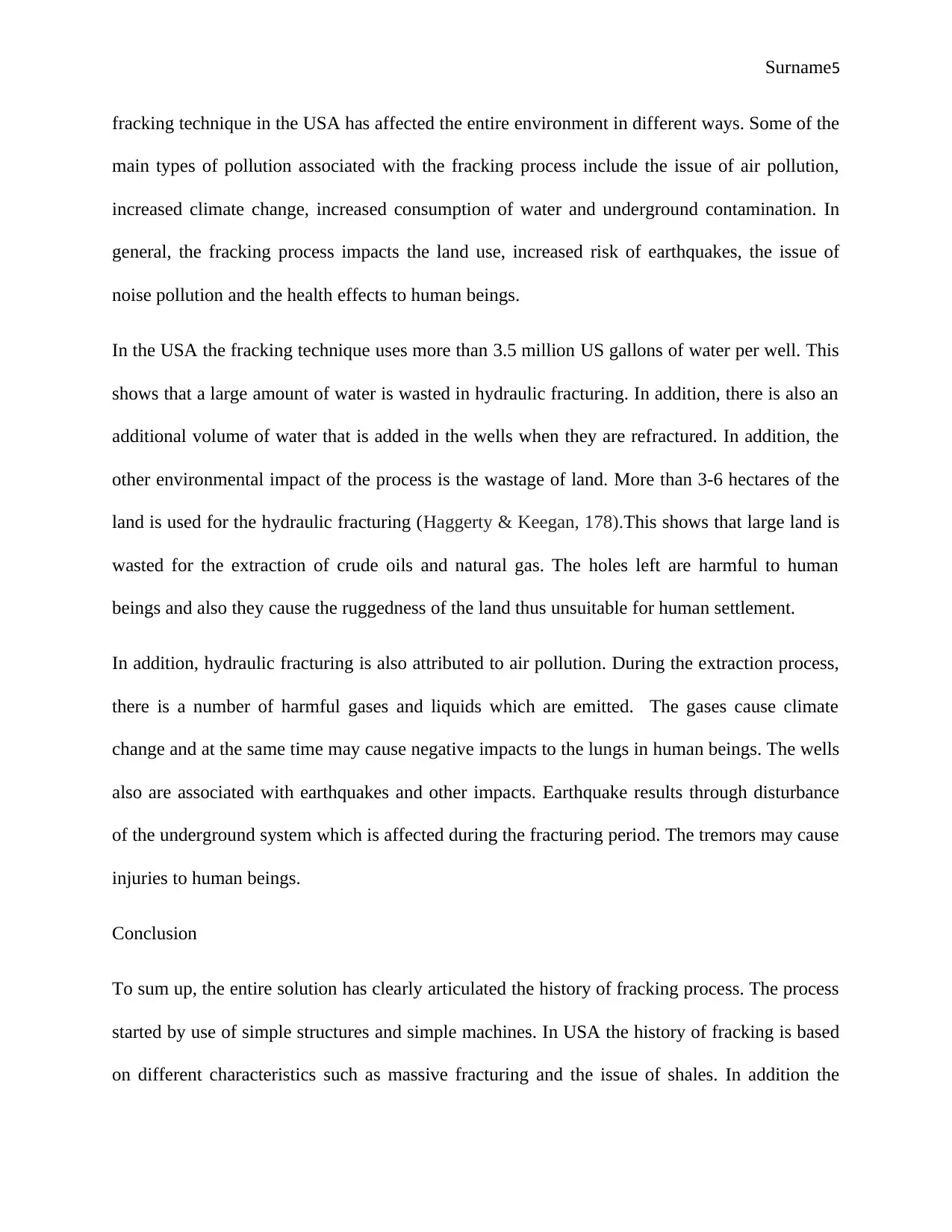
Surname5
fracking technique in the USA has affected the entire environment in different ways. Some of the
main types of pollution associated with the fracking process include the issue of air pollution,
increased climate change, increased consumption of water and underground contamination. In
general, the fracking process impacts the land use, increased risk of earthquakes, the issue of
noise pollution and the health effects to human beings.
In the USA the fracking technique uses more than 3.5 million US gallons of water per well. This
shows that a large amount of water is wasted in hydraulic fracturing. In addition, there is also an
additional volume of water that is added in the wells when they are refractured. In addition, the
other environmental impact of the process is the wastage of land. More than 3-6 hectares of the
land is used for the hydraulic fracturing (Haggerty & Keegan, 178).This shows that large land is
wasted for the extraction of crude oils and natural gas. The holes left are harmful to human
beings and also they cause the ruggedness of the land thus unsuitable for human settlement.
In addition, hydraulic fracturing is also attributed to air pollution. During the extraction process,
there is a number of harmful gases and liquids which are emitted. The gases cause climate
change and at the same time may cause negative impacts to the lungs in human beings. The wells
also are associated with earthquakes and other impacts. Earthquake results through disturbance
of the underground system which is affected during the fracturing period. The tremors may cause
injuries to human beings.
Conclusion
To sum up, the entire solution has clearly articulated the history of fracking process. The process
started by use of simple structures and simple machines. In USA the history of fracking is based
on different characteristics such as massive fracturing and the issue of shales. In addition the
fracking technique in the USA has affected the entire environment in different ways. Some of the
main types of pollution associated with the fracking process include the issue of air pollution,
increased climate change, increased consumption of water and underground contamination. In
general, the fracking process impacts the land use, increased risk of earthquakes, the issue of
noise pollution and the health effects to human beings.
In the USA the fracking technique uses more than 3.5 million US gallons of water per well. This
shows that a large amount of water is wasted in hydraulic fracturing. In addition, there is also an
additional volume of water that is added in the wells when they are refractured. In addition, the
other environmental impact of the process is the wastage of land. More than 3-6 hectares of the
land is used for the hydraulic fracturing (Haggerty & Keegan, 178).This shows that large land is
wasted for the extraction of crude oils and natural gas. The holes left are harmful to human
beings and also they cause the ruggedness of the land thus unsuitable for human settlement.
In addition, hydraulic fracturing is also attributed to air pollution. During the extraction process,
there is a number of harmful gases and liquids which are emitted. The gases cause climate
change and at the same time may cause negative impacts to the lungs in human beings. The wells
also are associated with earthquakes and other impacts. Earthquake results through disturbance
of the underground system which is affected during the fracturing period. The tremors may cause
injuries to human beings.
Conclusion
To sum up, the entire solution has clearly articulated the history of fracking process. The process
started by use of simple structures and simple machines. In USA the history of fracking is based
on different characteristics such as massive fracturing and the issue of shales. In addition the
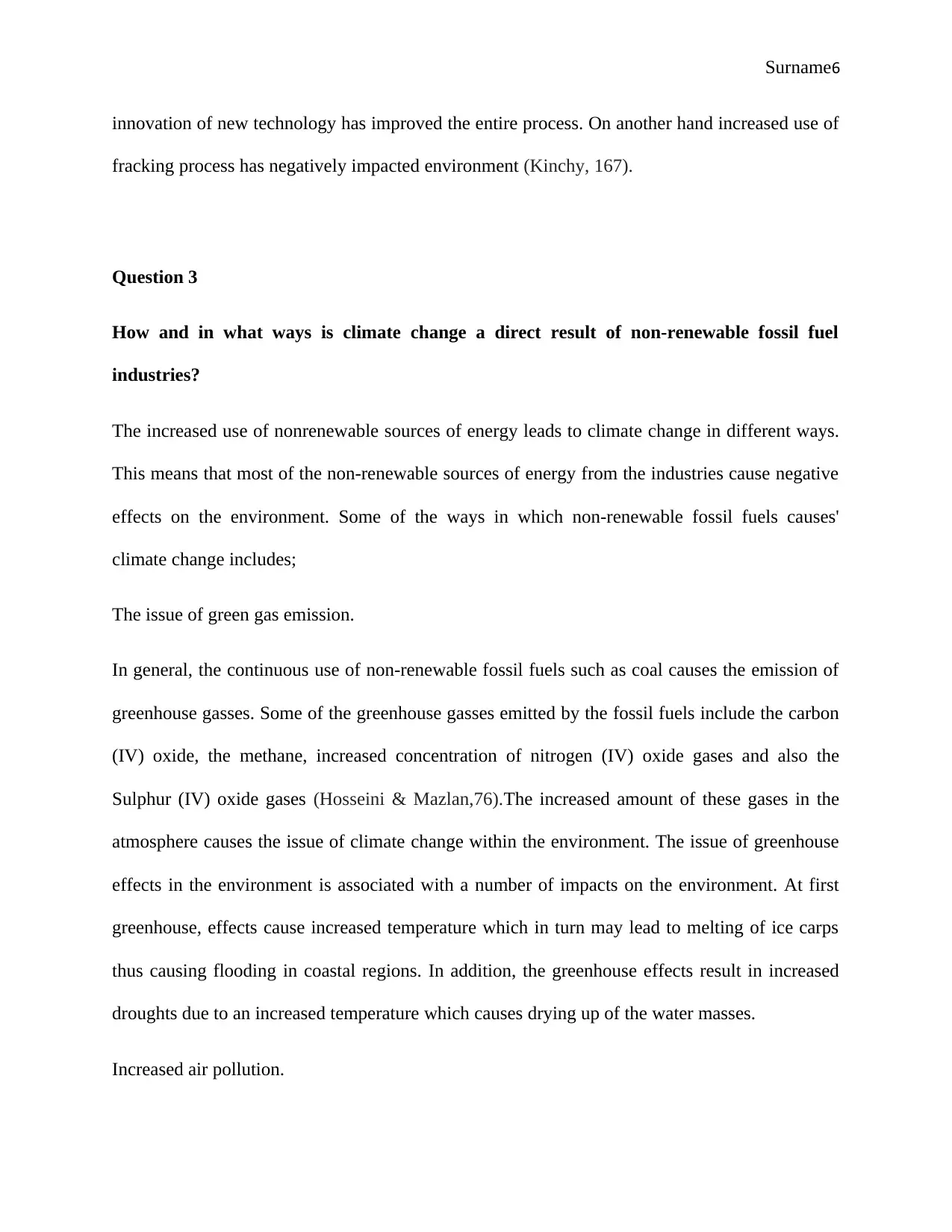
Surname6
innovation of new technology has improved the entire process. On another hand increased use of
fracking process has negatively impacted environment (Kinchy, 167).
Question 3
How and in what ways is climate change a direct result of non-renewable fossil fuel
industries?
The increased use of nonrenewable sources of energy leads to climate change in different ways.
This means that most of the non-renewable sources of energy from the industries cause negative
effects on the environment. Some of the ways in which non-renewable fossil fuels causes'
climate change includes;
The issue of green gas emission.
In general, the continuous use of non-renewable fossil fuels such as coal causes the emission of
greenhouse gasses. Some of the greenhouse gasses emitted by the fossil fuels include the carbon
(IV) oxide, the methane, increased concentration of nitrogen (IV) oxide gases and also the
Sulphur (IV) oxide gases (Hosseini & Mazlan,76).The increased amount of these gases in the
atmosphere causes the issue of climate change within the environment. The issue of greenhouse
effects in the environment is associated with a number of impacts on the environment. At first
greenhouse, effects cause increased temperature which in turn may lead to melting of ice carps
thus causing flooding in coastal regions. In addition, the greenhouse effects result in increased
droughts due to an increased temperature which causes drying up of the water masses.
Increased air pollution.
innovation of new technology has improved the entire process. On another hand increased use of
fracking process has negatively impacted environment (Kinchy, 167).
Question 3
How and in what ways is climate change a direct result of non-renewable fossil fuel
industries?
The increased use of nonrenewable sources of energy leads to climate change in different ways.
This means that most of the non-renewable sources of energy from the industries cause negative
effects on the environment. Some of the ways in which non-renewable fossil fuels causes'
climate change includes;
The issue of green gas emission.
In general, the continuous use of non-renewable fossil fuels such as coal causes the emission of
greenhouse gasses. Some of the greenhouse gasses emitted by the fossil fuels include the carbon
(IV) oxide, the methane, increased concentration of nitrogen (IV) oxide gases and also the
Sulphur (IV) oxide gases (Hosseini & Mazlan,76).The increased amount of these gases in the
atmosphere causes the issue of climate change within the environment. The issue of greenhouse
effects in the environment is associated with a number of impacts on the environment. At first
greenhouse, effects cause increased temperature which in turn may lead to melting of ice carps
thus causing flooding in coastal regions. In addition, the greenhouse effects result in increased
droughts due to an increased temperature which causes drying up of the water masses.
Increased air pollution.
⊘ This is a preview!⊘
Do you want full access?
Subscribe today to unlock all pages.

Trusted by 1+ million students worldwide
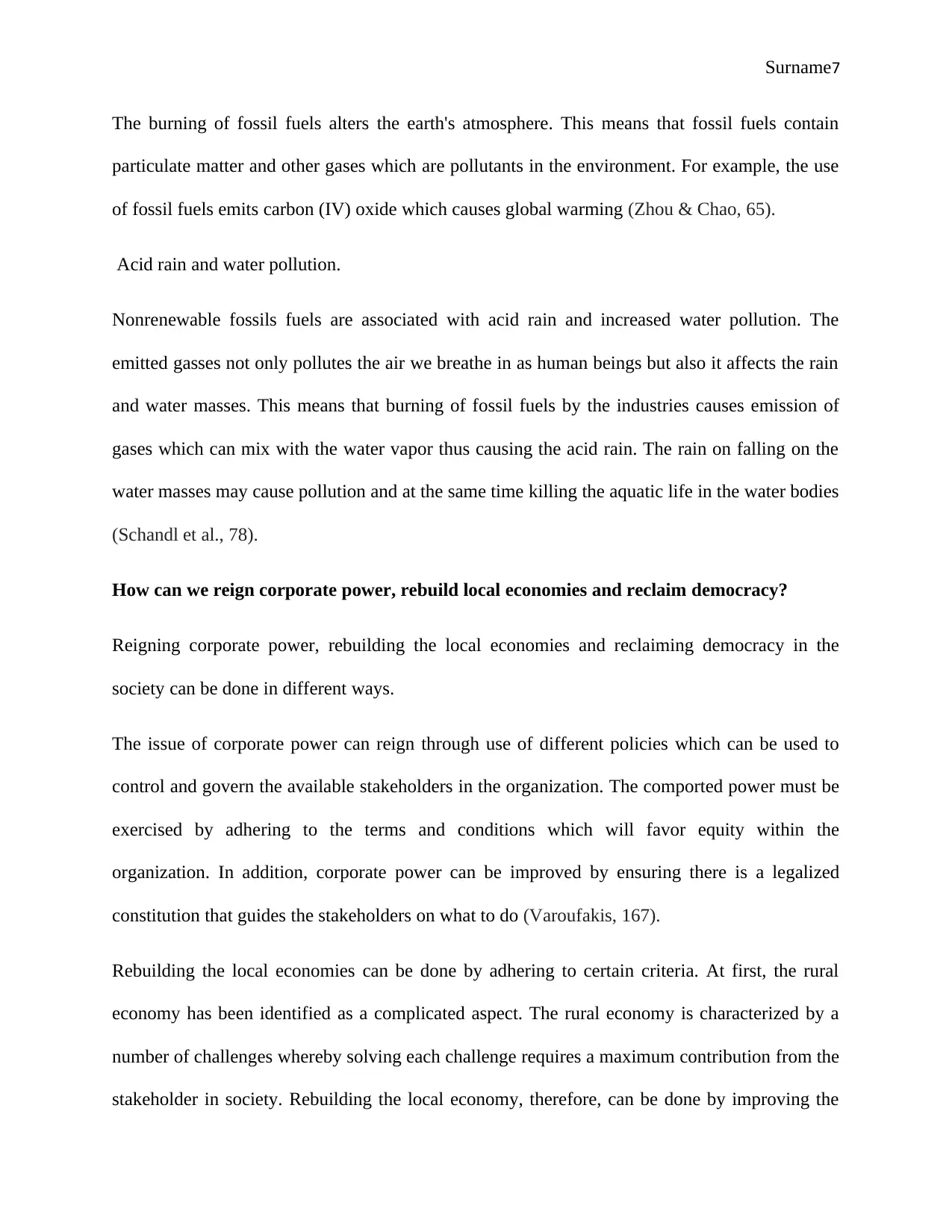
Surname7
The burning of fossil fuels alters the earth's atmosphere. This means that fossil fuels contain
particulate matter and other gases which are pollutants in the environment. For example, the use
of fossil fuels emits carbon (IV) oxide which causes global warming (Zhou & Chao, 65).
Acid rain and water pollution.
Nonrenewable fossils fuels are associated with acid rain and increased water pollution. The
emitted gasses not only pollutes the air we breathe in as human beings but also it affects the rain
and water masses. This means that burning of fossil fuels by the industries causes emission of
gases which can mix with the water vapor thus causing the acid rain. The rain on falling on the
water masses may cause pollution and at the same time killing the aquatic life in the water bodies
(Schandl et al., 78).
How can we reign corporate power, rebuild local economies and reclaim democracy?
Reigning corporate power, rebuilding the local economies and reclaiming democracy in the
society can be done in different ways.
The issue of corporate power can reign through use of different policies which can be used to
control and govern the available stakeholders in the organization. The comported power must be
exercised by adhering to the terms and conditions which will favor equity within the
organization. In addition, corporate power can be improved by ensuring there is a legalized
constitution that guides the stakeholders on what to do (Varoufakis, 167).
Rebuilding the local economies can be done by adhering to certain criteria. At first, the rural
economy has been identified as a complicated aspect. The rural economy is characterized by a
number of challenges whereby solving each challenge requires a maximum contribution from the
stakeholder in society. Rebuilding the local economy, therefore, can be done by improving the
The burning of fossil fuels alters the earth's atmosphere. This means that fossil fuels contain
particulate matter and other gases which are pollutants in the environment. For example, the use
of fossil fuels emits carbon (IV) oxide which causes global warming (Zhou & Chao, 65).
Acid rain and water pollution.
Nonrenewable fossils fuels are associated with acid rain and increased water pollution. The
emitted gasses not only pollutes the air we breathe in as human beings but also it affects the rain
and water masses. This means that burning of fossil fuels by the industries causes emission of
gases which can mix with the water vapor thus causing the acid rain. The rain on falling on the
water masses may cause pollution and at the same time killing the aquatic life in the water bodies
(Schandl et al., 78).
How can we reign corporate power, rebuild local economies and reclaim democracy?
Reigning corporate power, rebuilding the local economies and reclaiming democracy in the
society can be done in different ways.
The issue of corporate power can reign through use of different policies which can be used to
control and govern the available stakeholders in the organization. The comported power must be
exercised by adhering to the terms and conditions which will favor equity within the
organization. In addition, corporate power can be improved by ensuring there is a legalized
constitution that guides the stakeholders on what to do (Varoufakis, 167).
Rebuilding the local economies can be done by adhering to certain criteria. At first, the rural
economy has been identified as a complicated aspect. The rural economy is characterized by a
number of challenges whereby solving each challenge requires a maximum contribution from the
stakeholder in society. Rebuilding the local economy, therefore, can be done by improving the
Paraphrase This Document
Need a fresh take? Get an instant paraphrase of this document with our AI Paraphraser
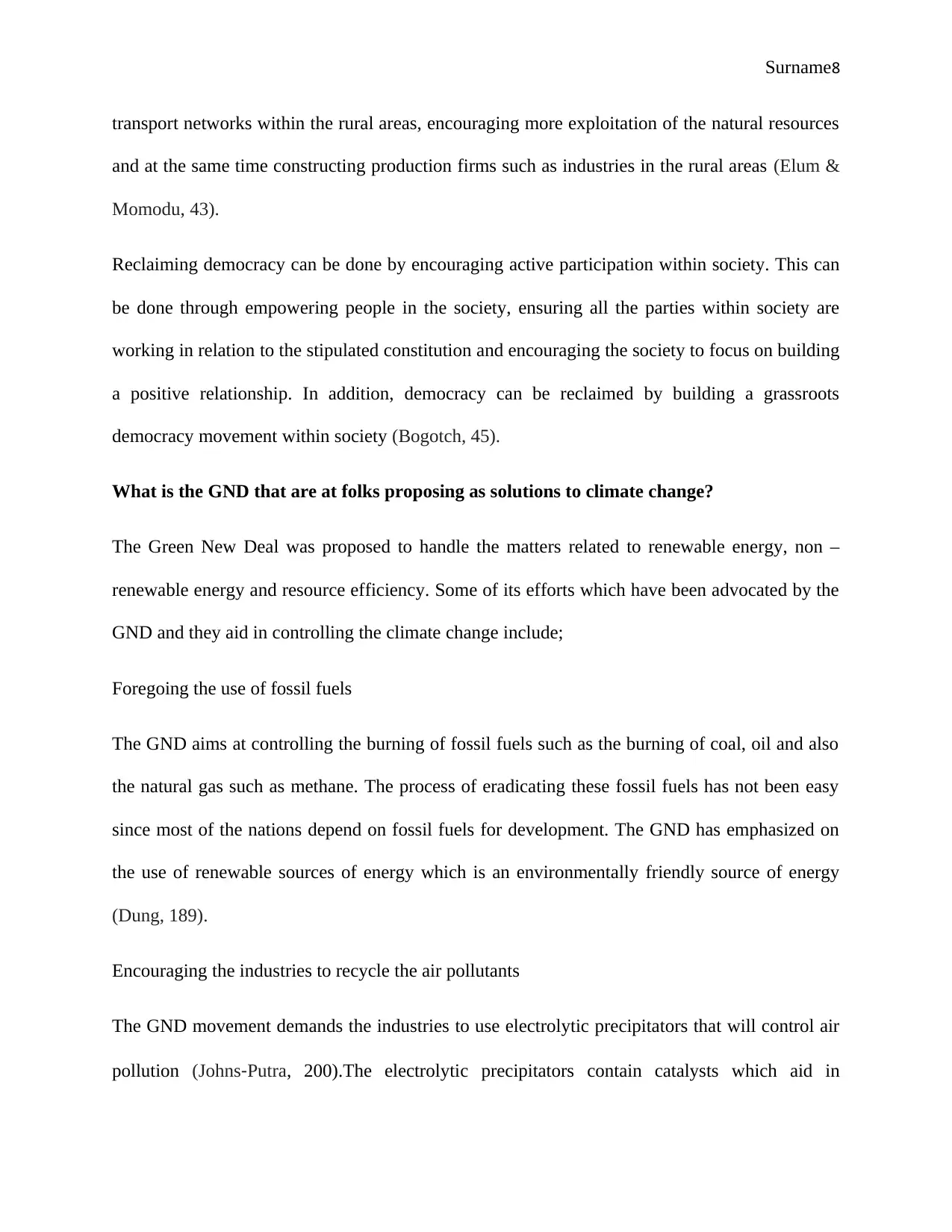
Surname8
transport networks within the rural areas, encouraging more exploitation of the natural resources
and at the same time constructing production firms such as industries in the rural areas (Elum &
Momodu, 43).
Reclaiming democracy can be done by encouraging active participation within society. This can
be done through empowering people in the society, ensuring all the parties within society are
working in relation to the stipulated constitution and encouraging the society to focus on building
a positive relationship. In addition, democracy can be reclaimed by building a grassroots
democracy movement within society (Bogotch, 45).
What is the GND that are at folks proposing as solutions to climate change?
The Green New Deal was proposed to handle the matters related to renewable energy, non –
renewable energy and resource efficiency. Some of its efforts which have been advocated by the
GND and they aid in controlling the climate change include;
Foregoing the use of fossil fuels
The GND aims at controlling the burning of fossil fuels such as the burning of coal, oil and also
the natural gas such as methane. The process of eradicating these fossil fuels has not been easy
since most of the nations depend on fossil fuels for development. The GND has emphasized on
the use of renewable sources of energy which is an environmentally friendly source of energy
(Dung, 189).
Encouraging the industries to recycle the air pollutants
The GND movement demands the industries to use electrolytic precipitators that will control air
pollution (Johns‐Putra, 200).The electrolytic precipitators contain catalysts which aid in
transport networks within the rural areas, encouraging more exploitation of the natural resources
and at the same time constructing production firms such as industries in the rural areas (Elum &
Momodu, 43).
Reclaiming democracy can be done by encouraging active participation within society. This can
be done through empowering people in the society, ensuring all the parties within society are
working in relation to the stipulated constitution and encouraging the society to focus on building
a positive relationship. In addition, democracy can be reclaimed by building a grassroots
democracy movement within society (Bogotch, 45).
What is the GND that are at folks proposing as solutions to climate change?
The Green New Deal was proposed to handle the matters related to renewable energy, non –
renewable energy and resource efficiency. Some of its efforts which have been advocated by the
GND and they aid in controlling the climate change include;
Foregoing the use of fossil fuels
The GND aims at controlling the burning of fossil fuels such as the burning of coal, oil and also
the natural gas such as methane. The process of eradicating these fossil fuels has not been easy
since most of the nations depend on fossil fuels for development. The GND has emphasized on
the use of renewable sources of energy which is an environmentally friendly source of energy
(Dung, 189).
Encouraging the industries to recycle the air pollutants
The GND movement demands the industries to use electrolytic precipitators that will control air
pollution (Johns‐Putra, 200).The electrolytic precipitators contain catalysts which aid in
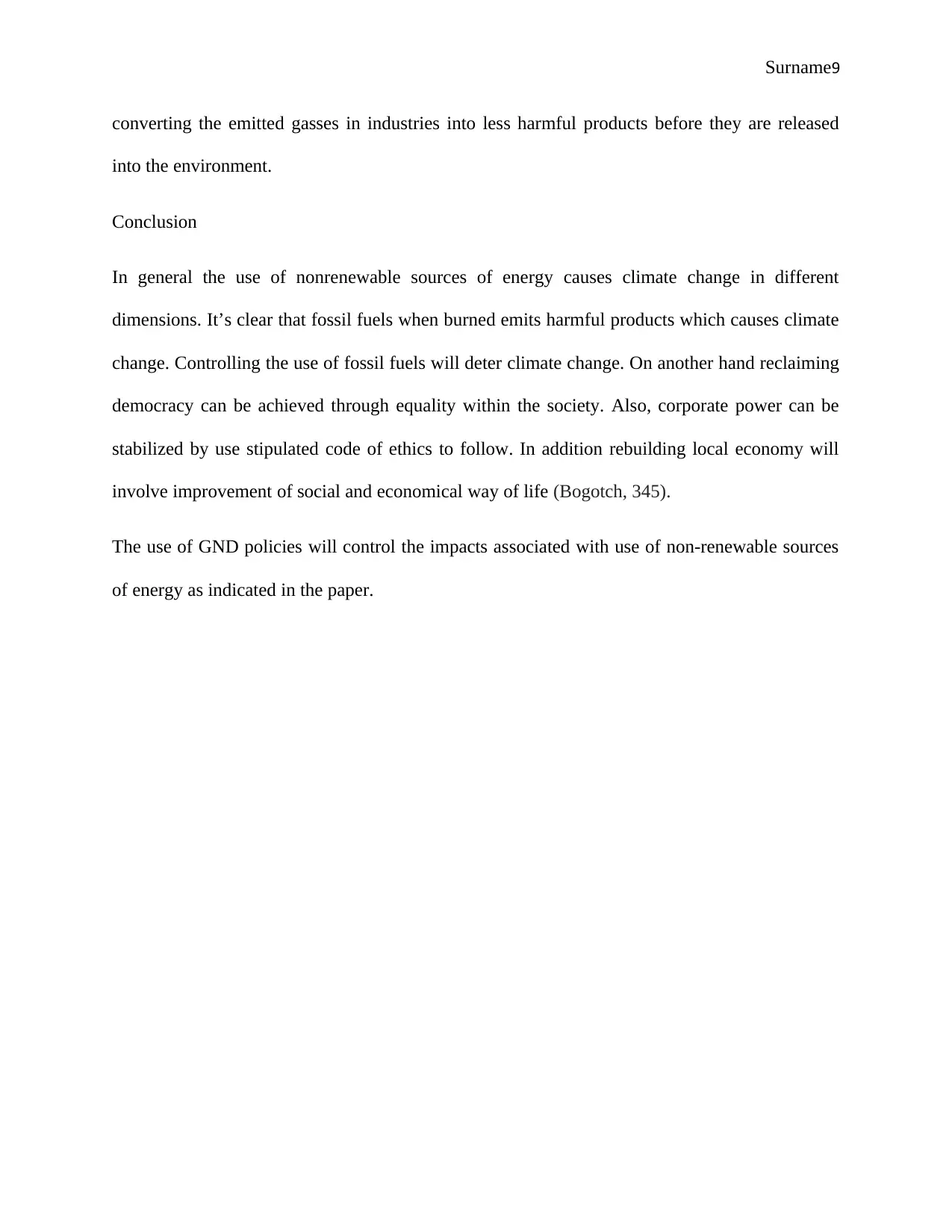
Surname9
converting the emitted gasses in industries into less harmful products before they are released
into the environment.
Conclusion
In general the use of nonrenewable sources of energy causes climate change in different
dimensions. It’s clear that fossil fuels when burned emits harmful products which causes climate
change. Controlling the use of fossil fuels will deter climate change. On another hand reclaiming
democracy can be achieved through equality within the society. Also, corporate power can be
stabilized by use stipulated code of ethics to follow. In addition rebuilding local economy will
involve improvement of social and economical way of life (Bogotch, 345).
The use of GND policies will control the impacts associated with use of non-renewable sources
of energy as indicated in the paper.
converting the emitted gasses in industries into less harmful products before they are released
into the environment.
Conclusion
In general the use of nonrenewable sources of energy causes climate change in different
dimensions. It’s clear that fossil fuels when burned emits harmful products which causes climate
change. Controlling the use of fossil fuels will deter climate change. On another hand reclaiming
democracy can be achieved through equality within the society. Also, corporate power can be
stabilized by use stipulated code of ethics to follow. In addition rebuilding local economy will
involve improvement of social and economical way of life (Bogotch, 345).
The use of GND policies will control the impacts associated with use of non-renewable sources
of energy as indicated in the paper.
⊘ This is a preview!⊘
Do you want full access?
Subscribe today to unlock all pages.

Trusted by 1+ million students worldwide
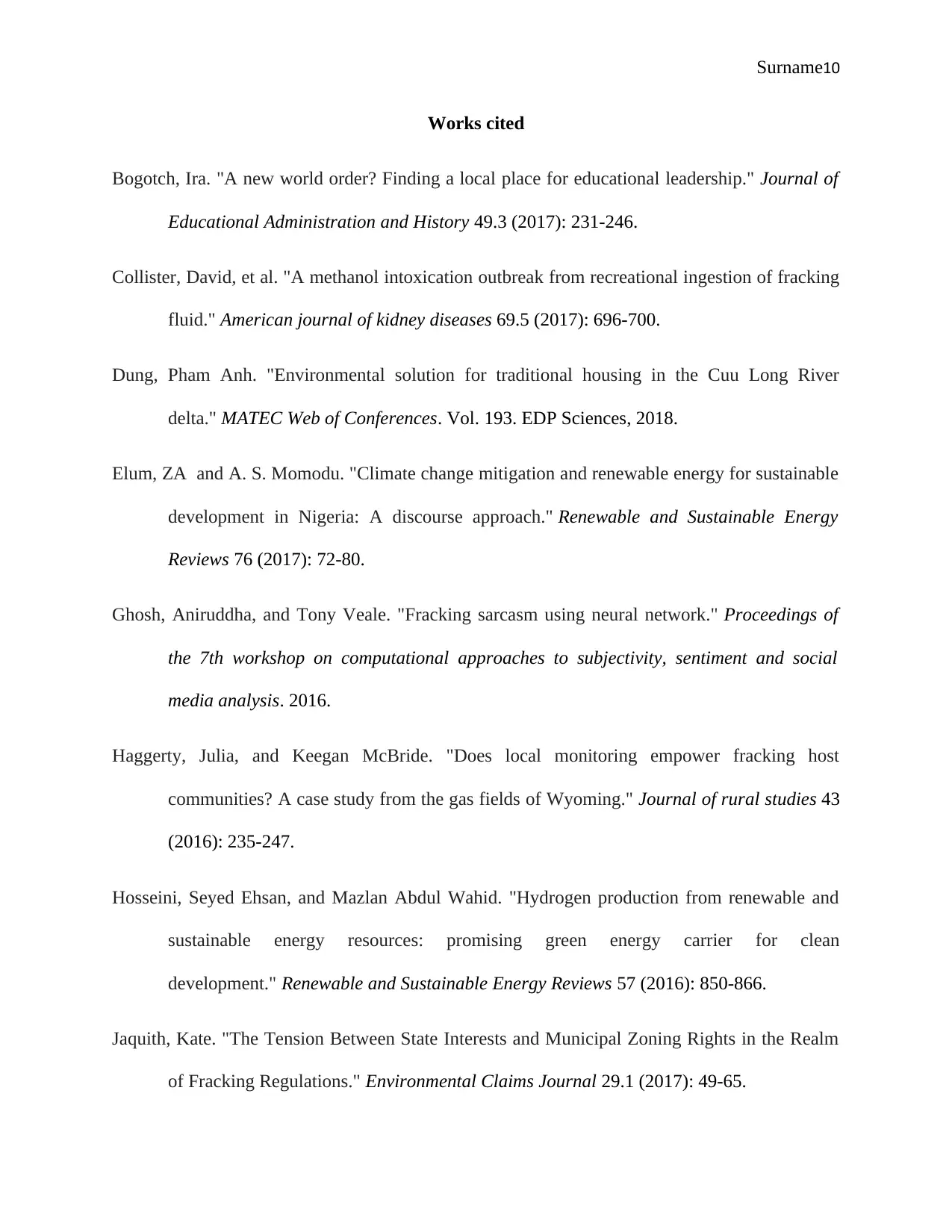
Surname10
Works cited
Bogotch, Ira. "A new world order? Finding a local place for educational leadership." Journal of
Educational Administration and History 49.3 (2017): 231-246.
Collister, David, et al. "A methanol intoxication outbreak from recreational ingestion of fracking
fluid." American journal of kidney diseases 69.5 (2017): 696-700.
Dung, Pham Anh. "Environmental solution for traditional housing in the Cuu Long River
delta." MATEC Web of Conferences. Vol. 193. EDP Sciences, 2018.
Elum, ZA and A. S. Momodu. "Climate change mitigation and renewable energy for sustainable
development in Nigeria: A discourse approach." Renewable and Sustainable Energy
Reviews 76 (2017): 72-80.
Ghosh, Aniruddha, and Tony Veale. "Fracking sarcasm using neural network." Proceedings of
the 7th workshop on computational approaches to subjectivity, sentiment and social
media analysis. 2016.
Haggerty, Julia, and Keegan McBride. "Does local monitoring empower fracking host
communities? A case study from the gas fields of Wyoming." Journal of rural studies 43
(2016): 235-247.
Hosseini, Seyed Ehsan, and Mazlan Abdul Wahid. "Hydrogen production from renewable and
sustainable energy resources: promising green energy carrier for clean
development." Renewable and Sustainable Energy Reviews 57 (2016): 850-866.
Jaquith, Kate. "The Tension Between State Interests and Municipal Zoning Rights in the Realm
of Fracking Regulations." Environmental Claims Journal 29.1 (2017): 49-65.
Works cited
Bogotch, Ira. "A new world order? Finding a local place for educational leadership." Journal of
Educational Administration and History 49.3 (2017): 231-246.
Collister, David, et al. "A methanol intoxication outbreak from recreational ingestion of fracking
fluid." American journal of kidney diseases 69.5 (2017): 696-700.
Dung, Pham Anh. "Environmental solution for traditional housing in the Cuu Long River
delta." MATEC Web of Conferences. Vol. 193. EDP Sciences, 2018.
Elum, ZA and A. S. Momodu. "Climate change mitigation and renewable energy for sustainable
development in Nigeria: A discourse approach." Renewable and Sustainable Energy
Reviews 76 (2017): 72-80.
Ghosh, Aniruddha, and Tony Veale. "Fracking sarcasm using neural network." Proceedings of
the 7th workshop on computational approaches to subjectivity, sentiment and social
media analysis. 2016.
Haggerty, Julia, and Keegan McBride. "Does local monitoring empower fracking host
communities? A case study from the gas fields of Wyoming." Journal of rural studies 43
(2016): 235-247.
Hosseini, Seyed Ehsan, and Mazlan Abdul Wahid. "Hydrogen production from renewable and
sustainable energy resources: promising green energy carrier for clean
development." Renewable and Sustainable Energy Reviews 57 (2016): 850-866.
Jaquith, Kate. "The Tension Between State Interests and Municipal Zoning Rights in the Realm
of Fracking Regulations." Environmental Claims Journal 29.1 (2017): 49-65.
Paraphrase This Document
Need a fresh take? Get an instant paraphrase of this document with our AI Paraphraser
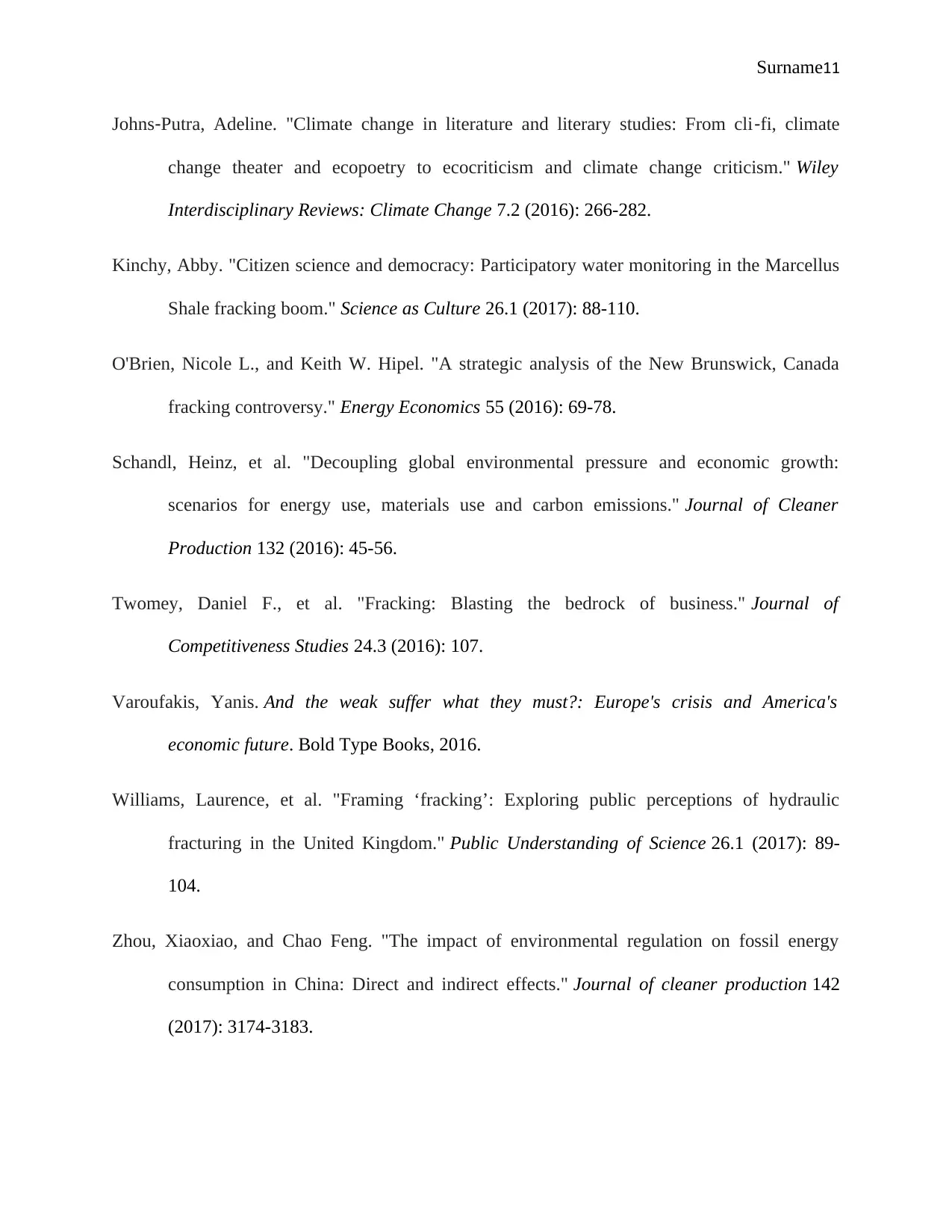
Surname11
Johns‐Putra, Adeline. "Climate change in literature and literary studies: From cli‐fi, climate
change theater and ecopoetry to ecocriticism and climate change criticism." Wiley
Interdisciplinary Reviews: Climate Change 7.2 (2016): 266-282.
Kinchy, Abby. "Citizen science and democracy: Participatory water monitoring in the Marcellus
Shale fracking boom." Science as Culture 26.1 (2017): 88-110.
O'Brien, Nicole L., and Keith W. Hipel. "A strategic analysis of the New Brunswick, Canada
fracking controversy." Energy Economics 55 (2016): 69-78.
Schandl, Heinz, et al. "Decoupling global environmental pressure and economic growth:
scenarios for energy use, materials use and carbon emissions." Journal of Cleaner
Production 132 (2016): 45-56.
Twomey, Daniel F., et al. "Fracking: Blasting the bedrock of business." Journal of
Competitiveness Studies 24.3 (2016): 107.
Varoufakis, Yanis. And the weak suffer what they must?: Europe's crisis and America's
economic future. Bold Type Books, 2016.
Williams, Laurence, et al. "Framing ‘fracking’: Exploring public perceptions of hydraulic
fracturing in the United Kingdom." Public Understanding of Science 26.1 (2017): 89-
104.
Zhou, Xiaoxiao, and Chao Feng. "The impact of environmental regulation on fossil energy
consumption in China: Direct and indirect effects." Journal of cleaner production 142
(2017): 3174-3183.
Johns‐Putra, Adeline. "Climate change in literature and literary studies: From cli‐fi, climate
change theater and ecopoetry to ecocriticism and climate change criticism." Wiley
Interdisciplinary Reviews: Climate Change 7.2 (2016): 266-282.
Kinchy, Abby. "Citizen science and democracy: Participatory water monitoring in the Marcellus
Shale fracking boom." Science as Culture 26.1 (2017): 88-110.
O'Brien, Nicole L., and Keith W. Hipel. "A strategic analysis of the New Brunswick, Canada
fracking controversy." Energy Economics 55 (2016): 69-78.
Schandl, Heinz, et al. "Decoupling global environmental pressure and economic growth:
scenarios for energy use, materials use and carbon emissions." Journal of Cleaner
Production 132 (2016): 45-56.
Twomey, Daniel F., et al. "Fracking: Blasting the bedrock of business." Journal of
Competitiveness Studies 24.3 (2016): 107.
Varoufakis, Yanis. And the weak suffer what they must?: Europe's crisis and America's
economic future. Bold Type Books, 2016.
Williams, Laurence, et al. "Framing ‘fracking’: Exploring public perceptions of hydraulic
fracturing in the United Kingdom." Public Understanding of Science 26.1 (2017): 89-
104.
Zhou, Xiaoxiao, and Chao Feng. "The impact of environmental regulation on fossil energy
consumption in China: Direct and indirect effects." Journal of cleaner production 142
(2017): 3174-3183.

Surname12
⊘ This is a preview!⊘
Do you want full access?
Subscribe today to unlock all pages.

Trusted by 1+ million students worldwide
1 out of 12
Your All-in-One AI-Powered Toolkit for Academic Success.
+13062052269
info@desklib.com
Available 24*7 on WhatsApp / Email
![[object Object]](/_next/static/media/star-bottom.7253800d.svg)
Unlock your academic potential
Copyright © 2020–2025 A2Z Services. All Rights Reserved. Developed and managed by ZUCOL.
